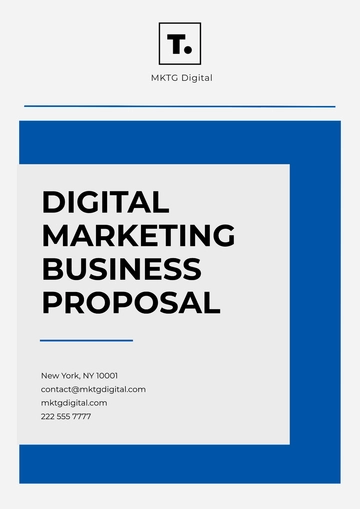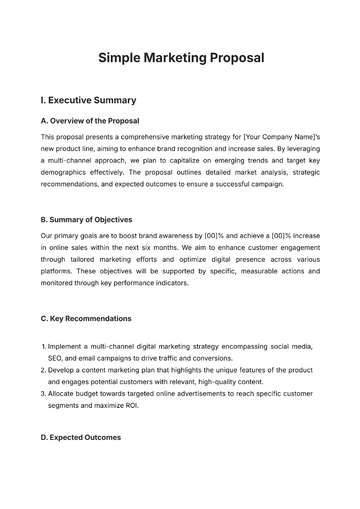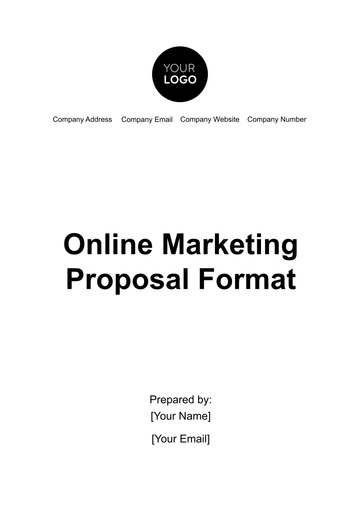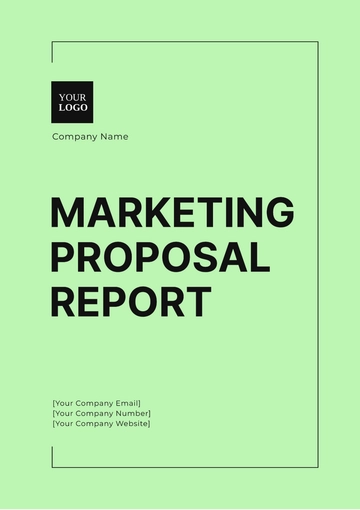Marketing Plan Proposal Outline
I. Executive Summary
A. Overview of the Proposal
(Describe the purpose of the marketing plan proposal. Summarize the main objectives and key elements of the plan. Explain the importance of the proposal for [Your Company Name] and how it will address specific business needs or challenges.)
B. Business Objectives
(Outline the primary business goals that the marketing plan aims to achieve. Detail how these objectives align with the overall strategic goals of [Your Company Name]. Include specific metrics or key performance indicators (KPIs) that will be used to measure success.)
C. Summary of Key Strategies
(Summarize the major strategies that will be employed to meet the business objectives. Highlight any innovative approaches or unique tactics that will differentiate [Your Company Name] from competitors. Include a brief overview of the target market and the marketing channels that will be utilized.)
II. Market Analysis
A. Industry Overview
(Provide a detailed analysis of the industry in which [Your Company Name] operates. Include information on market size, growth trends, and major industry players. Discuss any relevant economic, technological, or regulatory factors impacting the industry.)
B. Target Market Analysis
(Identify and describe the target market segments for [Your Company Name]. Include demographic, psychographic, and behavioral characteristics of the target audience. Provide data on market size, potential growth, and consumer needs.)
C. Competitive Analysis
(Analyze the competitive landscape. Identify key competitors and assess their strengths and weaknesses. Discuss their marketing strategies, market positioning, and any competitive advantages they may have. Explain how [Your Company Name] will position itself to compete effectively.)
D. SWOT Analysis
(Conduct a SWOT analysis for [Your Company Name]. Outline the company's internal strengths and weaknesses, as well as external opportunities and threats. Explain how the marketing plan will leverage strengths, address weaknesses, capitalize on opportunities, and mitigate threats.)
III. Marketing Objectives
A. Short-term Objectives
(Define the short-term marketing objectives for [Your Company Name]. These should be specific, measurable, achievable, relevant, and time-bound (SMART). Provide a timeline for achieving these objectives and outline the expected outcomes.)
B. Long-term Objectives
(Describe the long-term marketing goals and how they align with [Your Company Name]’s strategic vision. Include details on the anticipated impact of these objectives on the company’s market position and overall business success.)
C. Key Performance Indicators (KPIs)
(Identify the KPIs that will be used to track the progress and success of the marketing plan. Explain how these indicators will be measured and reported. Include both quantitative and qualitative metrics.)
IV. Marketing Strategies
A. Product Strategy
(Detail the product or service offerings of [Your Company Name]. Explain how these offerings meet the needs of the target market and differentiate from competitors. Discuss any planned changes, improvements, or new product developments.)
B. Pricing Strategy
(Outline the pricing strategy for [Your Company Name]. Include information on pricing models, discount structures, and pricing objectives. Discuss how the pricing strategy aligns with the target market’s expectations and the company’s financial goals.)
C. Promotion Strategy
(Describe the promotional tactics that will be used to reach the target audience. This may include advertising, public relations, content marketing, social media, events, and other promotional activities. Explain how these tactics will be integrated to create a cohesive promotional plan.)
D. Distribution Strategy
(Explain the distribution channels and methods that will be used to deliver products or services to the target market. Include details on any partnerships, logistics, and supply chain considerations. Discuss how the distribution strategy supports the overall marketing objectives.)
E. Digital Marketing Strategy
(Detail the digital marketing strategies to be employed. This may include search engine optimization (SEO), search engine marketing (SEM), social media marketing, email marketing, and online advertising. Explain how these strategies will enhance online presence and drive engagement.)
V. Implementation Plan
A. Action Plan
(Provide a detailed action plan outlining the steps required to execute the marketing strategies. Include a timeline with specific milestones, responsibilities, and deadlines. Ensure that the plan is realistic and achievable.)
B. Budget Allocation
(Outline the budget required for implementing the marketing plan. Break down the budget by category, such as advertising, promotions, digital marketing, and personnel. Justify the budget allocation and discuss how it aligns with the expected outcomes.)
C. Resource Allocation
(Detail the resources needed to execute the marketing plan. This may include personnel, technology, tools, and other assets. Explain how resources will be allocated and managed to ensure the successful implementation of the plan.)
VI. Monitoring and Evaluation
A. Performance Tracking
(Describe how the performance of the marketing plan will be tracked. Include details on the tools and methods that will be used to monitor progress. Explain how performance data will be collected and analyzed.)
B. Reporting Mechanisms
(Outline the reporting mechanisms for sharing performance results with stakeholders. Include details on the frequency of reports, the format, and the key metrics that will be highlighted. Discuss how reports will be used to make informed decisions.)
C. Plan Adjustments
(Explain the process for making adjustments to the marketing plan based on performance data and feedback. Describe how changes will be implemented and communicated. Ensure that there is a process for continuous improvement and adaptation.)
VII. Conclusion
A. Summary of Key Points
(Summarize the main points of the marketing plan proposal. Recap the objectives, strategies, and expected outcomes. Reinforce the importance of the plan for achieving the goals of [Your Company Name].)
B. Call to Action
(Include a call to action, encouraging stakeholders to approve or support the marketing plan. Provide any next steps or actions required to move forward with the implementation.)
C. Contact Information
(Provide contact information for further inquiries or discussions. Include details for key contacts within [Your Company Name] who can provide additional information or answer questions about the proposal.)
Marketing Templates @ Template.net






























